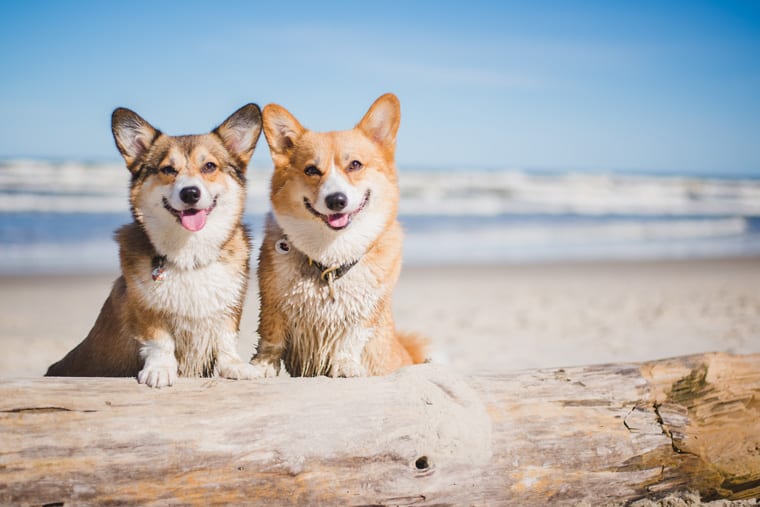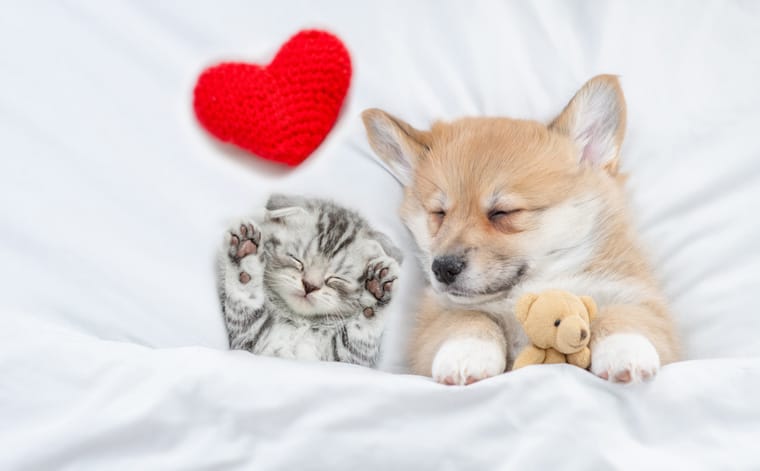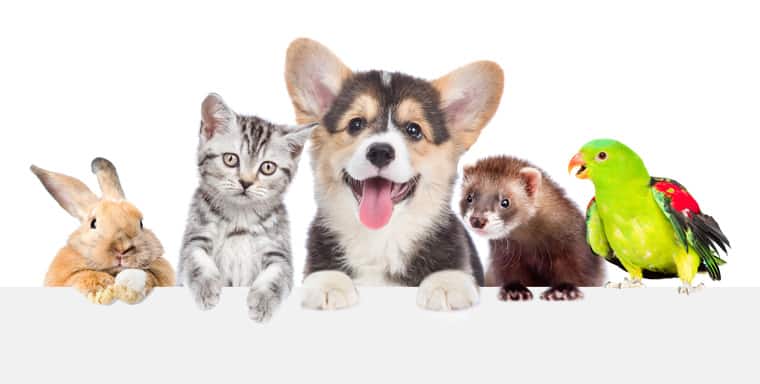Introducing your puppy to other pets
Obviously, you want all your pets to get along. Introducing your puppy to your other pets requires a proper introduction so they have a good initial impression of their newest family member.
Other dogs
If your other pet is a dog, the ideal initial introduction would be done outside, in an open, neutral area ideally off your property. Choose a neutral location that will be a safe area for your puppy where no unvaccinated dogs have been. Your current dog is less likely to view the newcomer as a territorial intruder if the introduction is done off your property. Each dog should be handled by a separate person. With both dogs on a leash, take them to an area which is unfamiliar, such as a neighbor’s yard. Have one person hold the other dog on the leash while you hold the pup in your arms. Let the other dog sniff the puppy while in your arms if it wants to. Do not force it to interact with the puppy. Quietly praise your other dog for being polite and or courteous. Once the other dog is satisfied, put the puppy on the ground away from the dog while on a leash and keep the puppy from approaching the other dog. Head off on a walk with the dogs walking parallel to each other with neither dog able to touch the other, nor the puppy following the other dog. Allow the older dog to sniff the puppy, if it is normally good with puppies. Do not allow the puppy to run up and jump on the adult dog. The goal isn’t that they interact physically, instead it is only that they spend time getting accustomed to each other. After 10 minutes or so, go home. Do not use food during this initial introduction because one of them may become obsessive about or protective of the food.
Be aware of body postures that indicate an aggressive response, including hair standing up on the dogs back, teeth baring, deep growls, a stiff legged gait or prolonged stare. If you see such postures, interrupt the interaction immediately by scooping up the puppy and getting the other dog interested in something else.
Once you get home, let the puppy in the house first, allowing it time to investigate this exciting new place. We firmly believe that puppies should be supervised and on a leash from the beginning at home so you can show them appropriate behavior in the house. Give the puppy a short tour and let it explore before putting it in a crate or pen. Now, bring in the adult dog and allow it to investigate the puppy smell in the house. Be aware that restricted spaces such as hallways and doorways are more likely to cause aggressive interactions since dogs are less able to give each other space. Praise the dog whenever the puppy is around. Spend some time with your older dog and tell it how wonderful it is for tolerating the youngster.
More than one dog
If you have more than one dog in your household, introduced the other dogs to the new puppy one at a time. Two or more adult dogs may have the tendency to gang up on or simply run over the newcomer. Use positive reinforcement to reward good behavior.
After the first meeting, you want your older dog to expect good things to happen when the puppy is around. Your older dog should get more treats, more praise and more polite when the puppy is visible, even if contained.


Dogs are NOT babysitters
Older dogs should not be seen as babysitters, nor should they be forced to tolerate those baby teeth constantly. Puppies usually pester adult dogs unmercifully. Do not allow your puppy and dog to be unsupervised until your puppy is four to five months old. Although your puppy has been raised with some good-tempered dogs who have taught them some canine language, before the age of four months puppies are not good at recognizing subtle body postures from adult dogs signaling that they have had enough. Keep your puppy contained in a pen, crate or small room so that your older dog has time away from your new puppy. A well socialized adult dog with a good temperament may set limits for puppies with a growl snarl or snap correction. These behaviors are normal and should be allowed. If however, your older dog grabs or bites the puppies step in quickly and remove the puppy. Adult dogs that are not well socialized or that have had a history of fighting with other dogs, may attempt to set limits with more aggressive behaviors, which could traumatize or physically harm the puppy. It is better to delay the introduction than to cause a lifetime problem for your puppy. No puppy should be left alone with an adult dog until it is house broken and the adult dog has shown you that the puppy is not in any danger. You should also be cautious of rough play between the older dog and a puppy. Puppies can seriously be hurt in a playtime accident. Most broken legs in puppies are caused by roughhousing with older dogs.
The "Puppy Scream"
The correction from an older dog is very likely to elicit the “Puppy Scream”. This sound is protective since most dogs will move away from a screaming puppy. If your puppy was corrected for an inappropriate behavior by an older dog, do not pick up the puppy and calm it. Let the lesson sink in so the puppy learns polite canine interactions. Do not correct the older dog for teaching the lesson either. However, if the puppy was innocently traumatized by something and you hear the “Puppy Scream”, pick it up and calm it until it stops screaming. This will reduce the chance that it will imprint on whatever frightened it.
Cats
Puppies younger than three months of age are unlikely to harm an adult cat but they won’t know how to read cat language. If you have cats at home do not just bring your new puppy inside and turn it loose to chase your cats. Instead, keep your puppy confined so that your cats can get accustomed to the new addition without having to interact. After time goes by, let them interact with your puppy while it is on a leash. If the cat runs from the puppy, the puppy may try to chase the cat and in doing so, may get hurt. Correct the puppy if it starts to chase the cat with a pop on the leash and the command leave it if it has been trained to understand that command. Once your puppy is old enough to have some freedom in the house, always ensure your cat can get away from the puppy, either by jumping over a baby gate or getting onto a piece of furniture. Puppies love cat food and cat poop. Move your cat’s food onto a table or counter or put it in a room where the puppy cannot have access. Litter boxes will also need to be protected to keep puppies out.
Other pets
We highly recommend that you control the interactions between your puppy and other pets. Dogs naturally have a high prey drive which is triggered by movements of prey animals such as ducks, rabbits, hamsters, gerbils and pet birds. Some dogs will never be trustworthy around such pets, although they can learn to tolerate their presence with human supervision. However, is better to be safe than sorry and let them live happily apart. Horses goats and cows can injure curious puppies. We encourage you to let your puppy see these animals but not have free interaction between them until your puppy is older and understands obedience commands. It only takes one kick to damage a puppy for a lifetime.




